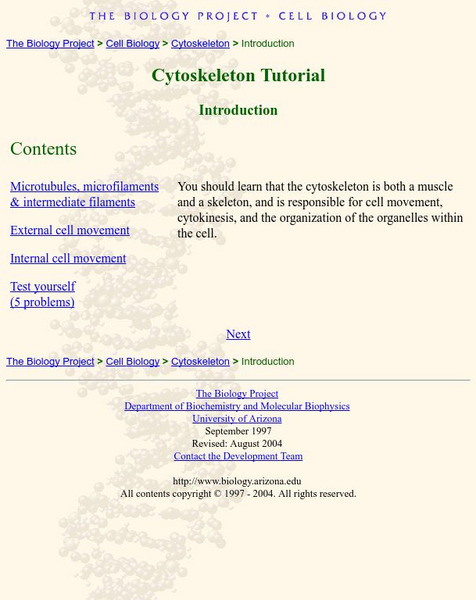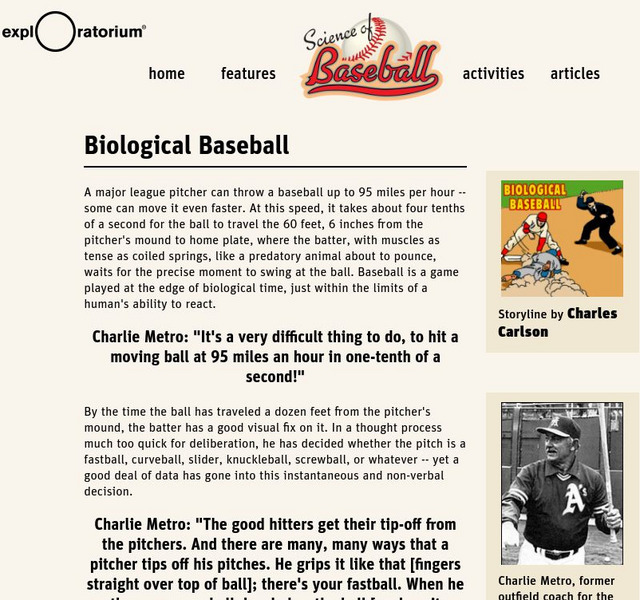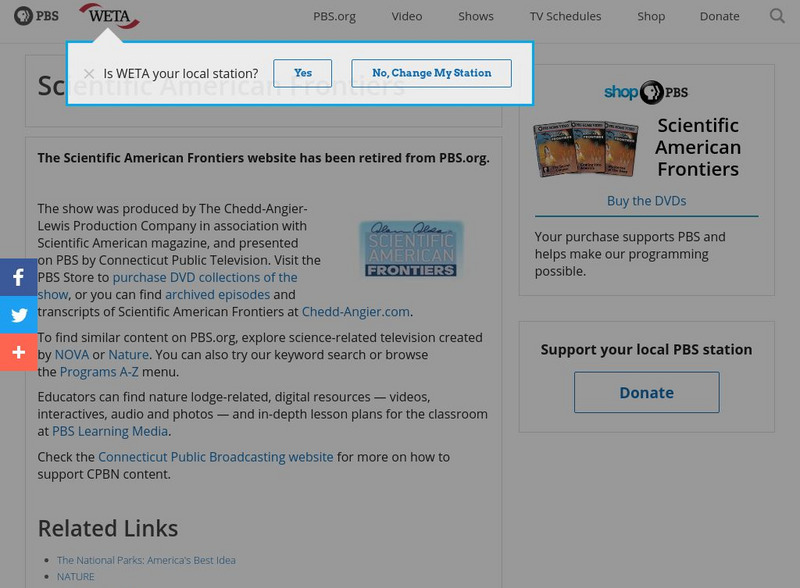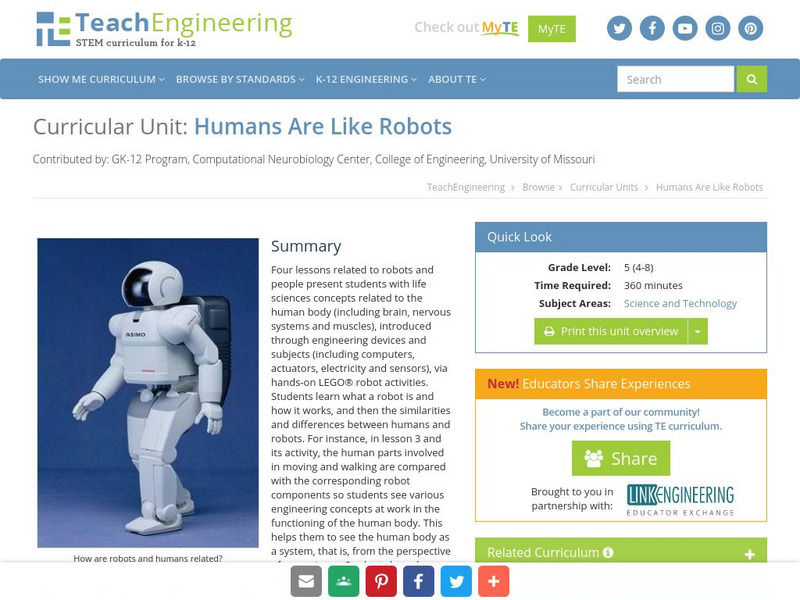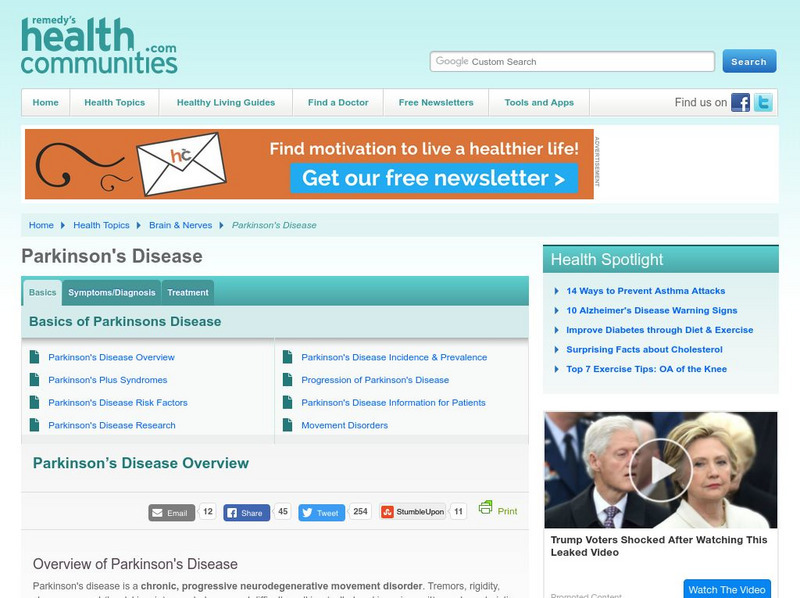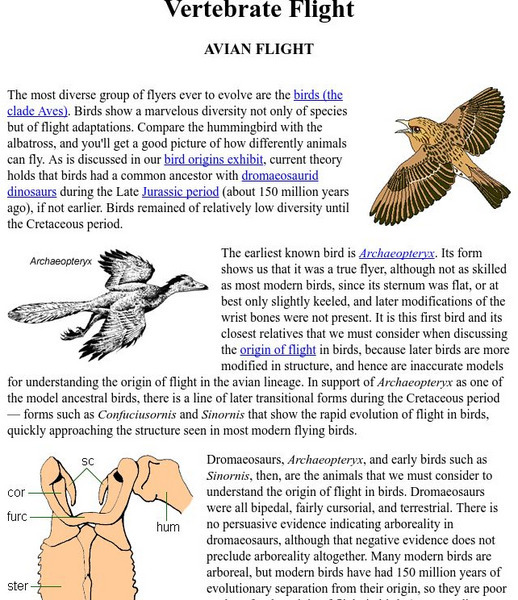Exploratorium
Exploratorium: Traits of Life: How Does a Muscle Work? [Pdf]
Poster illustrates how muscles turn energy into movement.
Ducksters
Ducksters: Biology for Kids: Muscles in the Human Body
Kids learn about the science of muscles in the human body. How we move and get around.
TeachEngineering
Teach Engineering: Muscles, Oh My!
Students are introduced to how engineering closely relates to the field of biomechanics and how the muscular system produces human movement. They learn the importance of the muscular system in our daily lives, why it is important to be...
Curated OER
Kids Health: Lou Gehrig's Disease
Lou Gehrig's Disease or ASL damages motor neurons which control muscle movement. Here you can find much information about this debilitating disease that rarely affects kids.
University of Michigan
Movement of the Hand
Movies of the hand muscles in action. Also has brief information on the hand muscles.
TeachEngineering
Teach Engineering: Walk, Run, Jump!
In this activity, students participate in a series of timed relay races using their skeletal muscles. The compare the movement of skeletal muscle and relate how engineers help astronauts exercise skeletal muscles in space.
E-learning for Kids
E Learning for Kids: Science: Diving School: How Do We Move?
Mariven lives in Barbados. He is going on a diving adventure to learn all about bones and muscles of the human body.
Other
Parkinson's Disease Foundation: Primary Symptoms
This resource, provided by the Parkinson's Disease Foundation, discusses the primary and secondary symptoms of Parkinson's Disease.
PBS
Pbs Kids: Sid the Science Kid: Sid Says
Make Sid move to match his father's movements and learn to identify where to find your muscles.
National Cancer Institute at the National Institutes of Health
Seer Training Modules: Introduction to the Muscular System
Self-guided learning activity where students learn about the structure and function of the human muscular system. There is a short quiz at the end of the lesson to check for understanding.
Alabama Learning Exchange
Alex: What Happened to Your Eye?
This is a virtual lab that investigates the effects of damage to eye muscles and nerves on the motion of the eyes. This lab is extremely realistic. This activity can be done as a whole class or as a demonstration.
University of Arizona
University of Arizona: Cytoskeleton Tutorial
In this interactive tutorial you will discover that the cytoskeleton is both a muscle and a skeleton, and is responsible for cell movement, cytokinesis, and the organization of the organelles within the cell.
American Museum of Natural History
American Museum of Natural History: Ology: Moving Mammals
Students explore the different ways mammals move by observing them walk, hop, gallop, swim and swing in animations. Facts about habitat and structure are also included in these animations.
Exploratorium
Exploratorium: Science of Baseball: Biological Baseball
Younger students learn that hitting a baseball requires the use of various brain to body reaction activities and how those compare to the instincts and actions of animals.
Other
Naeyc: Help Your Child Build Fine Motor Skills
There are lots of activities that can increase muscle strength and coordination, preparing children for more advanced skills, from writing with a pencil, using a computer mouse, or playing a musical instrument. Help your child build fine...
PBS
Pbs Teachers: Scientific American: It's a Kid's World: Body Sense
Investigate potential and kinetic energy by investigating the elasticity of a metal coil toy, the Slinky. Explore the development of muscle coordination in children and measure how practice improves performance of motor skills.
Mocomi & Anibrain Digital Technologies
Mocomi: Why Does My Eye Keep Twitching?
Learn about what causes eye twitching and some interesting superstitions in different cultures.
ClassFlow
Class Flow: Moving and Growing
[Free Registration/Login Required] In this unit children learn about how the skeleton is related to movement and support in humans and what happens to the skeleton and muscles as they move. They also compare human bones and skeletons...
TeachEngineering
Teach Engineering: Humans Are Like Robots
Four lessons related to robots and people present students with life sciences concepts related to the human body (including brain, nervous systems and muscles), introduced through engineering devices and subjects (including computers,...
TeachEngineering
Teach Engineering: Are We Like Robots?
Students explore the similarities between how humans move and walk and how robots move, so they come to see the human body as a system from an engineering point-of-view. Movement results from decision making (deciding to walk and move)...
Eastern Kentucky University
Eku: Comparative Vertebrate Anatomy Skeletal System
Lecture notes and diagrams about the skeletal system. Also includes a link to more lecture notes.
Other
Health Communities: Parkinson's Disease
This site discusses the mystery and complexity of Parkinson's Disease. It mentions the history of the disease, signs and symptoms and incidence.
University of California
Ucmp: Aves More on Morphology
A good discussion of the major adaptations of the skeleton of birds in order to adapt to flight.
University of California
Ucmp: Vertebrate Flight
A very solid Berkeley site on the structure and function of bird flight. Topics include skeletal and muscular adaptations for flight.
Other popular searches
- Bones and Muscle Movement
- Involuntary Muscle Movement
- Voluntary Muscle Movement
- Muscle Movement Skit
- Muscle Movement Chart
- Muscle Movement Teams
![Exploratorium: Traits of Life: How Does a Muscle Work? [Pdf] Graphic Exploratorium: Traits of Life: How Does a Muscle Work? [Pdf] Graphic](https://static.lp.lexp.cloud/images/attachment_defaults/resource/large/FPO-knovation.png)









